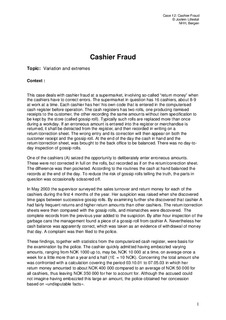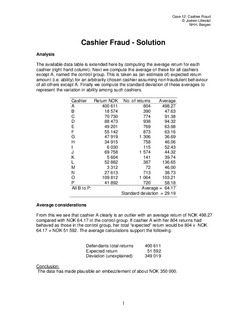| dc.description.abstract | Topic: Variation and extremes
Context :
This case deals with cashier fraud at a supermarket, involv¬ing so-called “return money” when the cashiers have to correct errors. The supermarket in question has 16 cashiers, about 8-9 at work at a time. Each cashier has her/ his own code that is entered in the computerised cash register before operation. The cash regis¬ters has two rolls, one producing itemised receipts to the customer, the other recording the same amounts without item specification to be kept by the store (called gossip roll). Typically such rolls are replaced more than once during a workday. If an erroneous amount is entered into the register or merchandise is returned, it shall be detracted from the register, and then recorded in writing on a return/correction sheet. The wrong entry and its correction will then appear on both the customer receipt and the gossip roll. At the end of the day the cash in hand and the return/correction sheet, was brought to the back office to be balanced. There was no day-to-day inspection of gossip rolls.
One of the cashiers (A) seized the opportunity to deliberately enter erroneous amounts. These were not corrected in full on the rolls, but recorded as if on the return/correction sheet. The difference was then pocketed. According to the routines the cash at hand balanced the records at the end of the day. To reduce the risk of gossip rolls telling the truth, the parts in question was occasionally scissored off.
In May 2003 the supervisor surveyed the sales turnover and return money for each of the cashiers during the first 4 months of the year. Her suspicion was raised when she discovered time gaps between successive gossip rolls. By examining further she discovered that cashier A had fairly frequent returns and higher return amounts than other cashiers. The return/correction sheets were then compared with the gossip rolls, and mismatches were discovered. The complete records from the previous year added to the suspicion. By after hour inspection of the garbage cans the management found a piece of a gossip roll from cashier A. Nevertheless her cash balance was apparently correct, which was taken as an evidence of withdrawal of money that day. A complaint was then filed to the police.
These findings, together with statistics from the computerized cash register, were basis for the examination by the police. The cashier quickly admitted having embezzled varying amounts, ranging from NOK 1000 up to, may be, NOK 10 000 at a time, on average once a week for a little more than a year and a half (1£ = 10 NOK). Concerning the total amount she was confronted with a calculation covering the period 03.10.01 to 07.05.03 in which her return money amounted to about NOK 400 000 compared to an average of NOK 50 000 for all cashiers, thus leaving NOK 350 000 for her to account for. Although the accused could not imagine having embezzled this large an amount, the police obtained her concession based on «undisputable facts».
The prosecutor to be quickly realised a possible flaw in using this calculation as basis for the accusation: The accused may have lower abilities than average at the outset, and should not be punished for that. In a criminal case «every penny» embezzled must be proved, and the average argument would be a gift to the defence. After preliminary consultation of statistical expertise, taking the variation of return money between cashiers into account as well, the accusation was reduced from about NOK 350 000 to NOK 300 000. A statistician was wanted as an expert witness, since statistical arguments of this kind had not previously been brought to the court.
The following commission was given to the statistician:
«To analyse the information made available and establish how much the return money of the accused deviates from natural variation among the cashiers in the store. State the assumptions of the analysis, and how sensitive it is to realistic changes of the assumptions».
Data
The available data included individual return amounts, number of returns, sales turnover among others, for every cashier and every work day in the period 03.10.01 to 07.05.03.
Some cashiers had worked more than others and in the file Cashier_Fraud.XLS we provide the total return amount and the number of returns for each cashier A to P.
In a separate sheet we give the return amount and the number of returns for each working day of cashier A, totalling 270 working days. Of these about 40 were in year 2001, 160 in 2002 and 70 in 2003.
Task:
1. Pretend you are the statistician faced by the commission above.
2. Investigate also when the supposed fraud started, and how it developed.
Teacher Note. The context and the commission may be given very brief. Afterwards the complete story can be revealed for discussion and critique. The case could alternatively be discussed from the point of view of the store supervisor, the police investigator, the prosecutor or the defence lawyer. You could even imagine role-playing. For the role of store supervisor you set the crime scene and reveal the suspicious circumstances and data, and then ask the student how to proceed. | nb_NO |


